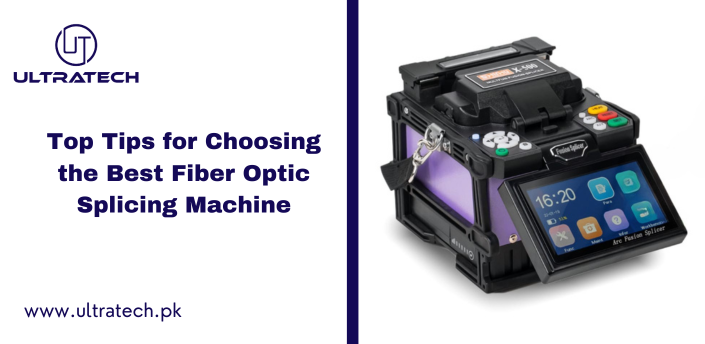
Top Tips for Choosing the Best Fiber Optic Splicing Machine
The most critical equipment for any work on fiber optic cables is the splicing machine. It is one such piece of equipment ensuring proper connection of two fibers with no interruptions in signal passage. Whether you're creating new networks or working with old ones, your work will require the best equipment to connect your components smoothly. From the basic factors in picking a fiber optic splicing machine to most popular ones of today, this manual takes you through all that.
What is a fiber optic splicing machine?
A fiber optic splicing machine joins together two areas of an optic fiber cable. These are mainly accomplished using fusion splicing or mechanical splicing. Fusion splicing requires heating to melt the fibers together into a long-lasting strong bond. When using mechanical splicing a sticky substance is required with which the fibers are aligned and then held so that they stay aligned. Far more common, though the less desirable, method in making high-quality, lasting connections is mechanical splicing.
Classifications of Machines for Fiber Optic Splicing
Fusion Splicing Machines and Mechanical Splicing Machines are the two main types of Fiber Optic Splicing Machines.
Things to Look for in a Fiber Optic Splicing Machine:
Therefore, deciding which particular fiber optic splicing machine suits ones requirements depends on some factors specific to potential use such as:
Loss at the splice point is referred to as splicing loss. Splicing loss should be minimum to ensure the strength of the signal. For a good machine, losses should be 0.01 dB or lower using right fusion splicing. The effect would thus be the minimum on the signal. Look at all machines' specifications of splicing loss and determine if they meet your needs.
Various fiber optic cables exist, among which there is a distinction between single-mode and multi-mode fibers. For more considerable distances, single-mode fibers are applicable while the most multi-mode fibers serve at lower distances. Thus, selection of a splicing machine has to depend on the fiber optic used as most new splicing machines cut across both types, however, it is safe and best to check prior.
A fiber optic splicing machine should be user-friendly. If you will be operating outdoors, you will not have much time to learn how the machine works. The simpler interface and automatic features found on your models, which include automatic fiber alignment and loss estimation, can save you time while reducing your chances of an error.
Portability is also important, especially for field operations. When you need to carry a splicing machine to different locations, choose one that is small and light. A portable machine will be easier to use and carry because it is meant to work outside the office, ideally for traveling technicians.
A long battery life is very important, especially if you are working in faraway places. A machine that can work through many splicing jobs without needing to recharge is the best choice. Also, think about how long it takes for the machine to recharge. Faster recharge times can help you keep to your plan, especially if you are working on big projects.
Durability is a factor. The fiber optic splicing machine has to operate in tough conditions, especially if outside. Look for machines that can handle the dust, moisture, and changes in temperature. There are shockproof machines too in case the machine falls or suffers rough handling.
One should be very keen in their selection as the price for a cheap machine is too low and could break after some few hours. More costly machines offer the best quality. Always check on a warranty which gives security assurance that when it gets spoiled, one will have his/her money back or another good machine in place of it.
Additional Features to Consider
Although the main features are crucial, there are additional functions on some machines that may enhance your experience. Some of these are as follows:
Types of Common Fiber Optic Splicing Machines
There are so many models today, and each model has its own characteristics. Among them are the following popular machines:
How to Care for your Fiber Optic Splicing Machine
The only thing that would grant your fiber optic splicing machine a longer life and good performance is regular maintenance. Here are the tips for your machine.
Conclusion
Proper and good fiber optic connections rely on the right fiber optic splicing machine. Consider splicing loss, compatibility of fiber types, ease of use, and portability in your decision-making. Once you have chosen the right machine, taking proper care of it ensures efficient completion of your fiber optic projects with minimal signal interruption. Always invest in a machine that meets your specific needs and provides the durability and performance needed to do good fiber optic splicing.
FAQs
How do I identify a good quality fiber optic splicing machine?
You find machines that are low in splicing loss and strong design with long-lasting battery life. They are easy to use and efficient for the most used types of fibers. Always check on the reviews and details before buying.
Will a splicing machine for fiber optics support single-mode and multi-mode fibers?
Yes, most nowadays fiber splicing machines work on both types of fibers. However, check the specification of the machine to ascertain if it meets your requirements.
How many hours does a fiber optic splicing machine work?
A fiber optic splicing machine lifespan is strictly based on usage and proper maintenance. Most machines last more than a few years given proper care. Proper cleaning and replacing parts will increase the lifespan of the machines.























